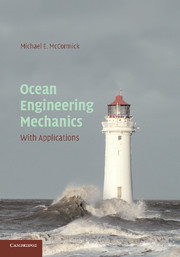Book contents
- Frontmatter
- Contents
- Preface
- Notation
- OCEAN ENGINEERING MECHANICS
- 1 Introduction
- 2 Review of Hydromechanics
- 3 Linear Surface Waves
- 4 Nonlinear Surface Waves
- 5 Random Seas
- 6 Wave Modification and Transformation
- 7 Waves in the Coastal Zone
- 8 Coastal Engineering Considerations
- 9 Wave-Induced Forces and Moments on Fixed Bodies
- 10 Introduction to Wave-Structure Interaction
- 11 Wave-Induced Motions of Floating Bodies
- 12 Wave-Induced Motions of Compliant Structures
- Appendices
- References
- Index
6 - Wave Modification and Transformation
Published online by Cambridge University Press: 05 June 2012
- Frontmatter
- Contents
- Preface
- Notation
- OCEAN ENGINEERING MECHANICS
- 1 Introduction
- 2 Review of Hydromechanics
- 3 Linear Surface Waves
- 4 Nonlinear Surface Waves
- 5 Random Seas
- 6 Wave Modification and Transformation
- 7 Waves in the Coastal Zone
- 8 Coastal Engineering Considerations
- 9 Wave-Induced Forces and Moments on Fixed Bodies
- 10 Introduction to Wave-Structure Interaction
- 11 Wave-Induced Motions of Floating Bodies
- 12 Wave-Induced Motions of Compliant Structures
- Appendices
- References
- Index
Summary
In Chapters 3 through 5, respectively, linear, nonlinear, and random waves are introduced, analyzed, and discussed. These waves are assumed to be affected by two physical boundaries, those being a flat, horizontal seafloor (or sea bed) and the free surface (at the air-water interface). In the present chapter, other boundaries are considered. These include vertical and sloping walls and sloping beds. The presence of these boundaries can cause the waves to be both modified (affecting the wave properties) and transformed (affecting the wave energy or energy flux). Specifically, the presence of boundaries causes waves to reflect, shoal, refract, and diffract. These wave phenomena and some of their engineering ramifications are discussed in the present chapter. An excellent “working document” covering the coastal engineering aspects of wave reflection, shoaling, refraction, and diffraction is the Shore Protection Manual of the Coastal Engineering Research Center (CERC) of the U.S. Army Corps of Engineers (see U.S. Army, 1984). A more recent CERC publication is the Automated Coastal Engineering System (User's Guide and Technical Reference), which is a computer-based document designed to assist coastal engineers in the predicting the behavior of waves (see Leenknecht, Szuwalski, and Sherlock, 1992). There are many other works available devoted to each wave phenomenon, the number being too large to individually reference in this chapter. For this reason, those works that are referred to in this chapter are those which are either encompassing or describe basic analyses, experiments, or prototype studies.
- Type
- Chapter
- Information
- Ocean Engineering MechanicsWith Applications, pp. 161 - 223Publisher: Cambridge University PressPrint publication year: 2009
- 1
- Cited by



